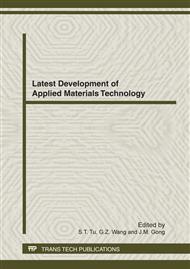p.1
p.10
p.12
p.16
p.22
p.28
p.36
p.40
Creep-Recovery Behaviors of Anisotropic Conductive Adhesive Film with Temperature and Hygrothermal Aging
Abstract:
The effects of temperature, stress level and hygrothermal aging on the creep-recovery behaviors of anisotropic conductive adhesive film (ACF) were investigated experimentally using a dynamic mechanical analyzer (DMA). It is found that the initial strains, instantaneous strains, and creep or recovery rates increase with increasing temperature,however decrease with increasing hygrothermal aging time. The change of creep or recovery rates at low temperature is apparent, however the creep or recovery rates increase obviously at temperatures above 25 oC with increasing stress level. For the hygrothermal aged ACF, the time to reach steady creep stage or steady recovery stage is reduced significantly compared with the unaged sample. The strain jumps at instantaneous loading decrease visibly and the strain jumps at instantaneous unloading decrease slightly with increasing aging time. And the strain jumps at instantaneous loading and unloading increase with increasing stress level for the unaged and aged ACFs.
Info:
Periodical:
Pages:
16-21
Citation:
Online since:
April 2012
Authors:
Price:
Сopyright:
© 2012 Trans Tech Publications Ltd. All Rights Reserved
Share:
Citation:


